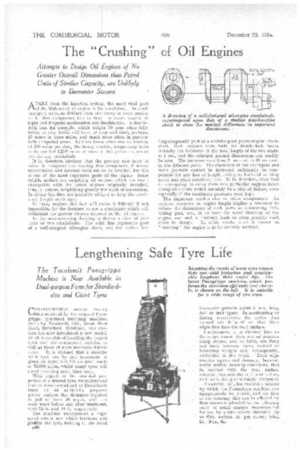The "Crushing" of Oil Engines
Page 38

If you've noticed an error in this article please click here to report it so we can fix it.
Attempts to Design Oil Engines of No Greater Overall Dimensions than Petrol Units of Similar Capacity, are Unlikely to Encounter Success
APART from the injection system, the most vital part of the high-speed oil engine is the crankshaft. In roadtransport work, as distinct from stationaryor even marine work, this component has to bear the extra burden of rapid and frequent acceleration and deceleratiOn. A double deck bus, for example, which weighs 10 tons when fully laden, in city traffic will have to stop and start, perhaps, 15 times in three miles, and much more often in particularly congested areas. As these buses often: run an average of 250 miles per day; the heavy starting torque may have to be exerted 1,250 times or more in this periocl.--a, severe test feuany crankshaft
It is, therefore, obvious that the greatest care must be taken in designing and making this component, if heavy maintenance and renewal costs are to be avoided, for this is one of the most expensive parts of the engine. Some vehicle makers are supplying oil engines which are interchangeable with the petrol engines originally installed, thus, of course, simplifying greatly the work of conversion. In doing this they are probably obliged to keep the crankshaft length unchanged.
In many engines this fact will make it difficult, if not impossible, for the designer to use a crankshaft which Will withstand the greater stresses imposed in the oil engine.
In the accompanying drawing is shown, a view of portions of two. crankshafts. The solid line represents part of a well-designed oil-engine shaft, and the dotted line
(superimposed) part of a well-designed petrol-engine crankshaft. Both engines were built for double-deck buses. Actually the difference in the total length.of the two shafts is 7 ins., and the enlarged general dimensions can readily be seen. The increases vary from 5 per cent to 30 per cent in the different parts. The diameters of the crankpins and main journals cannot be increased sufficiently to compensate for any loss of length, owing to limits of rubbing speed and other considerations. It is, therefore, clear that in attempting to make these two particular engines interchangeable there would certainly be a risk of failure, more especially if the maximum pressures were high.
The argument applies also to other components. An extreme economy in engine length implies a tendency to reduce the dimensions of such parts as connecting Tods, timing gear, etc., in at least the axial direction of the engine, and such a tendency leads to other possible weak
spots in design. In other words, what is known as " crushing " the engine is to be severely avoided.




















































































